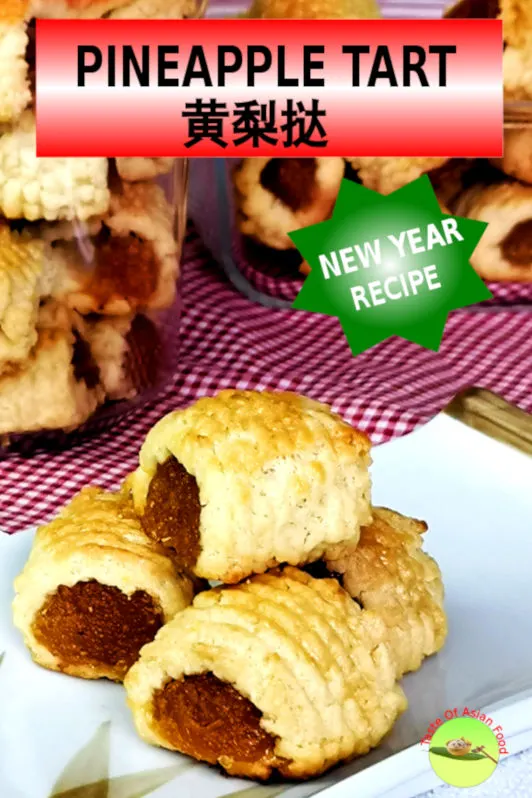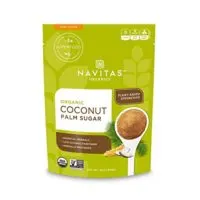I have just made the Pineapple tart for the forthcoming Chinese New Year.
This pineapple tart (黄梨挞, 黄梨酥) is intertwined with flavor and texture The crust is so crumbly you can hear it break under your fork (handle with care!) and the filling is the result of condensing the pineapple to a dense jam with only less than half of its original volume.
So let’s get started to show you how to prepare this festive delicacy that will definitely tempt your tastebuds and make you yearning for more.
Let’s dive into the details right away.
In the Hokkien dialect, the word pineapple pronounce as ong-lai 旺来, which is the homonym of the phrase ‘prosperity is arriving’. Therefore, it is most fitting for Chinese New Year as it signifies prosperity.

Note: This post may contain affiliate links. Please read my privacy policy for more info. I may receive commissions for purchases made through links in this post. As an Amazon Associate, I earn from qualifying purchases.
1. Prepare the pineapple filling
I usually start with the pineapple filling first, then followed by making the pastry. This way allows me to refrigerate the filling until it firms up while I am preparing the pastry. By the time I finish making the pastry, it is firm enough to handle easily for wrapping.
The flavor of this pineapple filling is slightly different from the Taiwanese pineapple cake, which I explain in detail in a separate article. Cloves, cinnamon bark, and star anise are used to flavor the filling. These spices are not used in the Taiwanese version.
Here are the steps
Cut the pineapple
- Cut off both ends of the pineapple. Then cut off the tough skin.
- Make two shallow V-shaped cuts to remove the eyes of the pineapple.
- Quarter the pineapple vertically, followed by cutting off the core, which is fibrous.
- Cut the pineapple flesh into small cubes.
- Blend the pineapple flesh into a puree with a food processor.
Cook the pineapple
- Transfer the pineapple puree to a pan. Gently heat the puree until it starts to boil.
- Add sugar, palm sugar, salt, star anise, cinnamon bark, cloves and simmer until it thickens. Stir occasionally to avoid it from sticking to the pan.
- Portion the jam to 8g each. Use two spoons to shape it to oblong, like a bullet.
- Place it in the refrigerator until it is firm to handle.
Tips
- Some people are allergic to raw pineapple. Use a pair of gloves if you are one of them.
- There is no harm to blend the pineapple longer. It will ensure the texture of the filling becomes smoother by doing so.
- You need to cook the pineapple puree until very thick. It shouldn’t have any visible liquid remain. It should be dry enough to hold the shape. Otherwise, the pineapple juice will drip onto the baking tray during baking.
- It is much easier to form the filling to oblong shape like a bullet by using two small stainless steel spoons. It is also less messy than by using your hands.
- You can use white sugar or brown sugar alone if palm sugar is not available. However, palm sugar is my preference due to its distinct flavor.
- The amount of sugar in the recipe is only for reference. The actual amount depends on the sweetness of the pineapple and the level of sweetness you prefer.
2. Make the pastry
The pastry for this recipe a slightly firmer than the Taiwanese pineapple cake because it has to be firm enough to roll out into strips while not ruin the pattern created by the unique mold.
Here are the steps
- Place the unsalted butter in a glass bowl.
- Add the icing sugar to butter when it is softened.
- Combine the butter and sugar to become buttercream.
- Add the beaten egg. Combine.
- Add salt, sieved flour, and custard powder to the butter-egg mixture.
- Combine all the ingredients until it comes together. Knead the dough briefly. The dough will pick up all the remaining flour in the bowl. The pastry is now ready to use.
Tips
- Excessive kneading will form gluten, which will make the pastry less crumbly, and bread-like. Stop kneading once it comes together and become a shiny mass to avoid this from happening.
- You may want to use an electric mixer if you plan to make a large batch. Otherwise, it is not difficult to do it manually with a fork.
- Add a small amount of water or egg if the pastry is too dry. The pastry should be pliable and will not break while rolling out and fold to encase the filling.

3. Wrapping and baking
You need to get the mold specially made to create the design of the pineapple tart. This type of mold is readily available in Malaysia. The mold that I use is only suitable for making a small quantity. If you intend to make a larger quantity. Look for the type of mold that comes with a plunger. This kind of mold can press out a long strip of dough, which speeds up the wrapping process considerably.
Here are the steps
- Fille up the mold with the dough.
- Press out a strip of pastry on a flat surface.
- Place a portion of the filling near the beginning of the strip.
- Roll up the strip carefully like making a swiss roll.
- Flatten both sides of the swiss roll with a plastic spatula.
- Transfer it to a baking tray lined with baking paper.
- Bake the pineapple tarts at 190°C/375°F for 10 minutes.
- Remove it from the oven.
- Brush the top of the pastry with egg wash.
- Return the pastry to the oven. Continue baking for another 10 minutes or until it turns golden brown.
Tips
- Keep your hands free from the pastry and filling. I highly recommend you to use a pair of gloves.
- What if you do not have the pineapple tart mold? An alternative method is to roll out the pastry, then cut it into strips. You may use those decorative rolling pins to create some patterns.
- Make sure where the two ends of the pastry meet are tucked at the bottom. This way will ensure the joining part of the pastry from opening up during baking.
- Do not apply the egg wash at the beginning of baking. The pastry is too soft at this moment. You are risking to destroy the pattern created if you use a brush to apply the egg wash. However, it is safe to do it after ten minutes of baking when the pastry is cooked.
- The pastry will turn color faster if you put the pastry at the upper deck of the oven.
Storage
Let the pineapple tarts cool at room temperature. Store the pineapple tarts in an airtight container. It will stay fresh for at least a month, which means you can make the pineapple tarts a few weeks before the Chinese New Year.

Pineapple Tart
Pineapple tart (黄梨挞, 黄梨酥) is the most traditional festive delicacy for Chinese New Year, which is only a few weeks away.
In the Hokkien dialect, the word pineapple pronounce as ong-lai 旺来, which is the homonym of the phrase ‘prosperity are arriving’. Therefore, it is most fitting for the occasion as it signifies prosperity.
Ingredients
For the filling:
- 350g (12.5 oz) pineapple
- 30g (2 tbsp) sugar white sugar
- 30g (2 tbsp) palm sugar
- 1/4 tsp salt
- 1/4 tsp cinnamon
- 2 cloves
- 1 star anise
For the crust:
- 120g (4.2 oz) butter
- 20g (3/4 oz) icing sugar
- 200g (7 oz) plain flour
- 12g (2 tbsp) custard powder
- 1g (1/4 tsp) salt
- 1 egg
Instructions
- Cut the pineapple flesh into small cubes.
- Blend the pineapple flesh into a puree.
- Gently heat the puree in a pan until it starts to boil.
- Add sugar, salt, star anise, cinnamon bark, and simmer until it thickens.
- Portion the jam to 8g each.
- Place it in the refrigerator until it is firm to handle.
- Combine the unsalted butter with icing sugar.
- Add the beaten egg. Combine.
- Add salt, sieved flour, and custard powder. Combine.
- Knead the dough briefly until it becomes shiny and no longer stick to the bowl.
- Press out a strip of pastry on a flat surface.
- Place a portion of the filling near the beginning of the strip.
- Roll up the strip carefully like making a swiss roll.
- Bake the pineapple tarts at 190°C/375°F for 10 minutes.
- Remove it from the oven.
- Brush the top of the pastry with egg wash.
- Continue baking for another 10 minutes or until it turns golden brown.
Recommended Products
As an Amazon Associate and member of other affiliate programs, I earn from qualifying purchases.
-
 Hamilton Beach 70725A 12-Cup Stack & Snap Food Processor and Vegetable Chopper Black
Hamilton Beach 70725A 12-Cup Stack & Snap Food Processor and Vegetable Chopper Black -
 Cake Decorating Embossed Rolling Pins,Textured Non-Stick Designs and Patterned,Ideal for Fondant,Pie Crust,Cookie,Pastry,Icing,Clay,Dough - Best Kit 8 Pcs
Cake Decorating Embossed Rolling Pins,Textured Non-Stick Designs and Patterned,Ideal for Fondant,Pie Crust,Cookie,Pastry,Icing,Clay,Dough - Best Kit 8 Pcs -
 Bird's Custard Powder 350g
Bird's Custard Powder 350g -
 Navitas Organics Coconut Palm Sugar, 16 oz. Bag — Organic, Non-GMO, Gluten-Free, Sustainable
Navitas Organics Coconut Palm Sugar, 16 oz. Bag — Organic, Non-GMO, Gluten-Free, Sustainable
Nutrition Information:
Yield: 20 Serving Size: 20 tartsAmount Per Serving: Calories: 29Total Fat: 0gSaturated Fat: 0gTrans Fat: 0gUnsaturated Fat: 0gCholesterol: 9mgSodium: 33mgCarbohydrates: 6gFiber: 0gSugar: 1gProtein: 1g
This data was provided and calculated by Nutritionix on 12/15/2019

Janet
Friday 29th of May 2020
Hi, can I use this recipe to wrap pineapple tarts? Thanks you
KP Kwan
Friday 29th of May 2020
Hi Janet, Sure. I have another similar recipe that you may be interested : https://tasteasianfood.com/taiwanese-pineapple-cake/ KP Kwan
KP Kwan
Sunday 15th of December 2019
Hi, this is KP Kwan. I am happy to see you in this comment area, as you have read through my recipe. I am pleased to reply to any questions and comments as soon as possible.